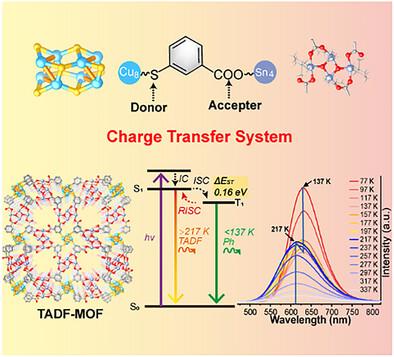当前位置:
X-MOL 学术
›
Adv. Mater.
›
论文详情
Our official English website, www.x-mol.net, welcomes your
feedback! (Note: you will need to create a separate account there.)
Heterocluster-Assembled Crystalline Hydrophobic Complexes with Delayed Fluorescence
Advanced Materials ( IF 27.4 ) Pub Date : 2025-06-04 , DOI: 10.1002/adma.202505734
Jing He, Liang He, Minyi Zhang, Jian Zhang, Qipu Lin
Advanced Materials ( IF 27.4 ) Pub Date : 2025-06-04 , DOI: 10.1002/adma.202505734
Jing He, Liang He, Minyi Zhang, Jian Zhang, Qipu Lin

|
Metal–organic frameworks (MOFs) with metal─sulfur bonds exhibit unique electrical, redox, and optical properties. However, their development has been hindered by rapid nucleation during crystallization. To address this challenge, amine-based modulators to retard nucleation through competitive coordination with ligands, enabling the synthesis of a series of Cu-S cluster-based MOFs with diverse network topologies: Cu-BDT-hcb (1), Cu-TBT-acs (2), Cu-TBT-pcu (3), Cu-TBT-sql (4), Cu-TBT-dia (5), and Cu-TBT-hcb (6), are utilized. Using donor-acceptor (D-A) ligands (o/p-mercaptobenzoic acid—o/pMBA), [Sn4]-based MOFs: Sn-oDTBA-cds (7) and Sn-pDTBA-pcu (8), are fabricated. During synthesis, sulfhydryl groups underwent reductive coupling to generate novel dicarboxylate ligands with disulfide (S–S) linkages. Notably, the first bimetallic heterocluster MOF, SnCu-mMBA-dia (9), incorporating both a metal-oxygen cluster [Sn4O2(carboxylate)4] and a metal-sulfur cluster [Cu8(thiolate)8] is developed. This framework, constructed using m-mercaptobenzoic acid (mMBA) as a D–A bifunctional ligand, exhibits spatially separated HOMO and LUMO, minimizing the singlet–triplet energy gap to promote thermally activated delayed fluorescence (TADF). Compound 9 also demonstrates exceptional hydrolytic stability due to steric shielding by hydrophobic organotin moieties. This work pioneers a modulator-assisted strategy for heterocluster MOF construction, offering a paradigm for designing stable luminescent materials with tailored optoelectronic functionalities.
中文翻译:

具有延迟荧光的异源聚集结晶疏水配合物
具有金属硫键的金属有机框架 (MOF) 表现出独特的电学、氧化还原和光学特性。然而,它们的发育受到结晶过程中快速成核的阻碍。为了应对这一挑战,利用胺基调节剂通过与配体的竞争性配位来延缓成核,从而能够合成一系列具有不同网络拓扑结构的基于 Cu-S 簇的 MOF:Cu-BDT-hcb (1)、Cu-TBT-acs (2)、Cu-TBT-pcu (3)、Cu-TBT-sql (4)、Cu-TBT-dia (5) 和 Cu-TBT-hcb (6)。使用供体-受体 (D-A) 配体 (o/p-巯基苯甲酸—o/pMBA),制备基于 [Sn4] 的 MOF:Sn-o DTBA-cds (7) 和 Sn-p DTBA-pcu (8)。在合成过程中,巯基发生还原偶联,生成具有二硫键 (S-S) 键的新型二羧酸配体。值得注意的是,开发了第一个双金属异质团聚 MOF SnCu-m MBA-dia (9),它结合了金属-氧团簇 [Sn4O2(羧酸盐)4] 和金属-硫团簇 [Cu8(硫酸盐)8]。该框架使用 m-巯基苯甲酸 (mMBA) 作为 D-A 双功能配体构建,表现出空间分离的 HOMO 和 LUMO,最大限度地减少单线态-三重态能隙以促进热激活延迟荧光 (TADF)。化合物 9 还由于疏水性有机锡部分的空间屏蔽而表现出优异的水解稳定性。 这项工作开创了一种用于异质簇 MOF 构建的调制器辅助策略,为设计具有定制光电功能的稳定发光材料提供了一种范式。
更新日期:2025-06-04
中文翻译:

具有延迟荧光的异源聚集结晶疏水配合物
具有金属硫键的金属有机框架 (MOF) 表现出独特的电学、氧化还原和光学特性。然而,它们的发育受到结晶过程中快速成核的阻碍。为了应对这一挑战,利用胺基调节剂通过与配体的竞争性配位来延缓成核,从而能够合成一系列具有不同网络拓扑结构的基于 Cu-S 簇的 MOF:Cu-BDT-hcb (1)、Cu-TBT-acs (2)、Cu-TBT-pcu (3)、Cu-TBT-sql (4)、Cu-TBT-dia (5) 和 Cu-TBT-hcb (6)。使用供体-受体 (D-A) 配体 (o/p-巯基苯甲酸—o/pMBA),制备基于 [Sn4] 的 MOF:Sn-o DTBA-cds (7) 和 Sn-p DTBA-pcu (8)。在合成过程中,巯基发生还原偶联,生成具有二硫键 (S-S) 键的新型二羧酸配体。值得注意的是,开发了第一个双金属异质团聚 MOF SnCu-m MBA-dia (9),它结合了金属-氧团簇 [Sn4O2(羧酸盐)4] 和金属-硫团簇 [Cu8(硫酸盐)8]。该框架使用 m-巯基苯甲酸 (mMBA) 作为 D-A 双功能配体构建,表现出空间分离的 HOMO 和 LUMO,最大限度地减少单线态-三重态能隙以促进热激活延迟荧光 (TADF)。化合物 9 还由于疏水性有机锡部分的空间屏蔽而表现出优异的水解稳定性。 这项工作开创了一种用于异质簇 MOF 构建的调制器辅助策略,为设计具有定制光电功能的稳定发光材料提供了一种范式。


















































 京公网安备 11010802027423号
京公网安备 11010802027423号